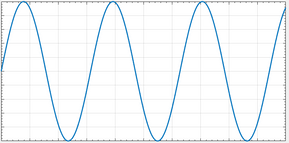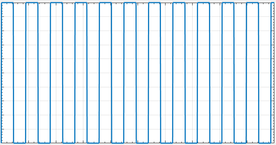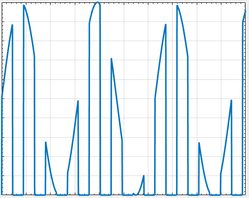- Subscribe to RSS Feed
- Mark Topic as New
- Mark Topic as Read
- Float this Topic for Current User
- Bookmark
- Subscribe
- Mute
- Printer Friendly Page
Controlling two timed analogue outputs independently
Solved!03-28-2023 07:28 AM
- Mark as New
- Bookmark
- Subscribe
- Mute
- Subscribe to RSS Feed
- Permalink
- Report to a Moderator
Hello,
I'm trying to design a system that has two devices that are each independently controlled by an analogue and digital signal using a PCIe-6363 NI DAQ card. The digital signal is defined as a series of duty cycles and frequencies on a counter line and the analogue signal is a 0-10V signal that is sampled at 1kHz. These signals are then convolved to get the device's output:
Analogue: 
Convolved:
The digital signals I can control using counter lines, so that isn't a problem. However, I'm having trouble with controlling the analogue outputs. They need to send a data point at 1kHz sample rate, so I was hoping to control them with a clock. The attached VI does work, but the two analogue inputs are timed by the same sample clock, and so I've had to set them up on the same task. This means I can't control the analogue outputs independently i.e. they have to be turned on and off or altered simultaneously. Is there a way for me to use the sample clock to time both of the analogue output lines independently at the same sample rate?
If you run the code, it won't actually do anything without the devices in between, but I hope it makes sense despite that. Here's an image of what it reads with the devices in:
Thanks,
Daniel
Solved! Go to Solution.
03-28-2023 07:30 AM
- Mark as New
- Bookmark
- Subscribe
- Mute
- Subscribe to RSS Feed
- Permalink
- Report to a Moderator
Sorry, I forgot to attach the VI in the first message XD
03-28-2023 07:48 AM
- Mark as New
- Bookmark
- Subscribe
- Mute
- Subscribe to RSS Feed
- Permalink
- Report to a Moderator
If you need to truly control each AO line independently, you need a simultaneous output DAQ, unfortunately, your DAQ has only one Timing Engine that can support AO task and hence any AO that needs control has to use the same Timing Engine and hence same task.
Soliton Technologies
New to the forum? Please read community guidelines and how to ask smart questions
Only two ways to appreciate someone who spent their free time to reply/answer your question - give them Kudos or mark their reply as the answer/solution
03-28-2023 08:14 AM
- Mark as New
- Bookmark
- Subscribe
- Mute
- Subscribe to RSS Feed
- Permalink
- Report to a Moderator
Thanks for the quick reply. That seems pretty definitive. So there's no way to, say, link the two analogue outputs to the same clock at a constant sample rate, and then write to them separately? Or would that still require more than one Timing Engine?
It's still workable if I have to run them through the same task. I'm just going to have to modularly create tasks based on the number of active devices.
03-28-2023 08:28 AM
- Mark as New
- Bookmark
- Subscribe
- Mute
- Subscribe to RSS Feed
- Permalink
- Report to a Moderator
Thanks for the quick reply! That sounds pretty definitive then. So there's no way to link two analogue output lines to a sample clock at a constant sample rate and then activate those independently? That would require more than one Timing Engine?
I can still work around it if I can't control them independently. I'll just need to create the tasks modularly based on which devices are active. It's less flexible, but I think it should work.
03-28-2023 08:30 AM
- Mark as New
- Bookmark
- Subscribe
- Mute
- Subscribe to RSS Feed
- Permalink
- Report to a Moderator
You've to update all channels in a task and not selectively.
Soliton Technologies
New to the forum? Please read community guidelines and how to ask smart questions
Only two ways to appreciate someone who spent their free time to reply/answer your question - give them Kudos or mark their reply as the answer/solution
03-28-2023 08:50 AM
- Mark as New
- Bookmark
- Subscribe
- Mute
- Subscribe to RSS Feed
- Permalink
- Report to a Moderator
See Case 5 of Error -50103 When Using NI-DAQ™mx With LabVIEW or in NI-MAX
You can refer to Two Analog Output Waveforms With Different Frequencies and/or Different Waveform Types as well.
Applications Engineer | TME Systems
https://tmesystems.net/
-------------------------------------------------------
https://github.com/ZhiYang-Ong



